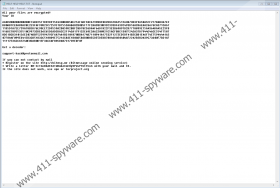Scarab-Apple Ransomware Removal Guide
Scarab-Apple Ransomware drops a document called HELP HELP HELP.TXT in which the victim should see a message asking to email support-hack@protonmail.com. It says the user’s files were encrypted and that by contacting the hackers the user can get a decryptor. We should warn you it could be a terrible idea because you will most likely be asked to pay for it and as you probably realize yourself there are no guarantees when dealing with cybercriminals. In other words, if you put up with their demands, you still might not get the decryptor, and the money would be lost in vain. For those of you who do not want to deal with the hackers, we would advise deleting Scarab-Apple Ransomware. The encrypted files might be lost, but if you have a backup, you could use it to recover at least some of them. The instructions located below can help you erase the malware manually, or you could employ a reliable security tool.
Our specialists think Scarab-Apple Ransomware might be distributed via Spam messages. Such messages ought to contain a file or a link to some site. The email might urge to open the file/link for various reasons. For example, in some cases, victims receive attachments that look like photos with a short note saying the user is in the picture. Other attacks are more sophisticated as they imitate emails of various well-known companies. Such messages may claim you have to change some password or that there is a mistake in your order. Naturally, there are tons of scenarios the cybercriminals may use, so the best you can do is to never let your guard down. Any message urging you to take action or raising a suspicion should be checked with a reliable antimalware tool. Doing so can prevent you from opening infected attachments unknowingly.
If the malicious application gets in it should start with encrypting user’s files. During this process, the data might be renamed and marked with .Apple extension. Afterward, they become unusable, although it is possible they could be restored with the right decryption tools. As mentioned earlier Scarab-Apple Ransomware’s creators should mention a decryptor in the ransom note, as they ask to message or email them to get it. The announcement with instructions on how to contact the hackers should be placed in the %USERPROFILE% directory. The malicious application might also create a Registry entry in the HKEY_CURRENT_USER\Software\Microsoft\Windows\CurrentVersion\Run location to make sure the mentioned document gets launched together with the system upon it restarting. Provided you do not like seeing it, and you wish your computer to be malware-free, we encourage you to erase Scarab-Apple Ransomware. As for writing to the cybercriminals, we recommend against it since there is a chance they could scam you.
Probably the easiest way to get rid of the malicious application is to scan the computer with a reliable security tool. Once the scan is complete, it should allow you to remove all identified threats at the same time. However, if you prefer deleting Scarab-Apple Ransomware manually, you could complete the steps listed in the instructions located below this text.
Get rid of Scarab-Apple Ransomware
- Tap Ctrl+Alt+Delete.
- Pick Task Manager.
- Select the Processes tab.
- Look for a process associated with the malware.
- Select the process and click End Task.
- Leave Task Manager.
- Tap Win+E.
- Go to these locations:
%TEMP%
%USERPROFILE%\Downloads
%USERPROFILE%\Desktop - Find the malicious file opened before the system got infected, right-click it and select Delete.
- Navigate to this path %USERPROFILE%
- Search for a document titled HELP HELP HELP.TXT, right-click it and select Delete.
- Close File Explorer.
- Tap Win+R.
- Type Regedit and click Enter.
- Go to these locations separately:
HKEY_CURRENT_USER\Software
HKEY_CURRENT_USER\Software\Microsoft\Windows\CurrentVersion\Run - Identify the malware’s created value names, e.g., Nvpnl (the title ought to be random), right-click them and press Delete.
- Close Registry Editor.
- Empty Recycle Bin.
- Restart the computer.
Scarab-Apple Ransomware Screenshots:


